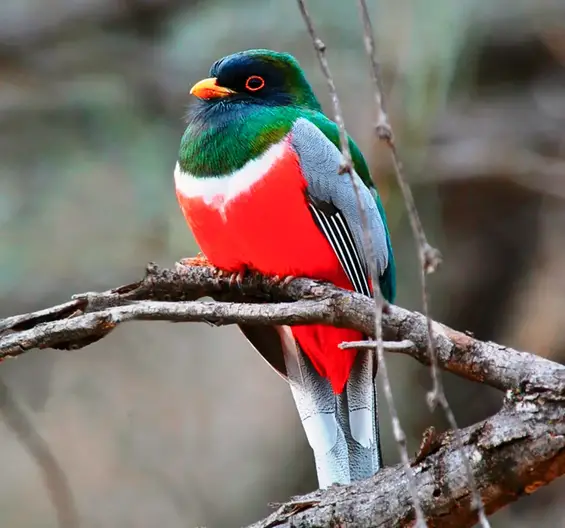
Come explore the fascinating world of the Red-naped Trogon (Harpactes kasumba), a magnificent bird that belongs to the trogon family. With its stunning colors and elegant demeanor, this species is considered one of the most breathtaking in its group. In this article, we’ll delve into the physical characteristics, behavior, habitat, and conservation status of this remarkable creature. Whether you’re an avid bird enthusiast or simply someone who appreciates the beauty of nature, join us on a journey to uncover the captivating features of the Red-naped Trogon.

The Red-naped Trogon is a moderately sized bird that measures approximately 30 centimeters long. This remarkable bird has a distinct feature that sets it apart from other species. It’s marked by a vibrant crimson patch on the back of its neck, which is where it gets its name. Its feathers are an impressive blend of bright orange on the belly and a dark metallic green on the upper part, making it a beautiful sight to behold. Interestingly, distinguishing between male and female Red-naped Trogons is quite tricky, as they possess similar physical characteristics.

The Red-naped Trogon is easily identifiable due to its striking long and wide tail that features eye-catching black and white patterns. This bird’s agility in traversing the forest canopy is impressive, as it uses its small wings in conjunction with its distinctive tail.

The Red-naped Trogon is a bird species that can be easily spotted in the tropical and subtropical forests of Southeast Asia. This bird is commonly found in countries like Thailand, Myanmar, Malaysia, and Indonesia. It can thrive in various forest habitats, including primary and secondary forests, as well as bamboo thickets.

Red-naped trogons are typically solitary animals, although they may form pairs during the breeding season. They prefer to be active at night and spend their daylight hours perched on tree branches located in the upper parts of the forest. The trogons are always alert, looking out for potential prey.

The Red-naped Trogon has a diet that mainly consists of insects like termites, beetles, ants, and caterpillars. However, they also occasionally consume small fruits and berries. When hunting, they use a unique technique where they quickly attack their prey mid-air but remain stationary on their perch. During courtship displays, the male Red-naped Trogon showcases interesting behaviors such as fluffing its feathers and spreading its wings to display its eye-catching plumage. The bird’s melodious call is used to communicate with potential partners and set territorial boundaries.

The survival of the Red-naped Trogon is in peril due to various threats. The loss of their habitat is a significant danger as logging and deforestation activities have caused a decline in their population. The birds are adversely affected by the destruction of their natural environment, which results from logging for wood extraction, agriculture, and urbanization.
Moreover, the illegal trade of these birds as exotic pets has become an alarming problem. Many individuals capture and sell Red-naped Trogons illegally, leading to their removal from their habitat, disrupting their migration patterns, and endangering their existence in the wild.

The Red-naped Trogon’s continuance is dependent upon the dedicated conservation efforts of various organizations and advocates. These individuals work tirelessly to safeguard its habitat, increase awareness, and enforce animal welfare laws. It is crucial to incorporate the neighboring community and implement sustainable forestry practices to ensure the trogon’s environment remains undisturbed.
